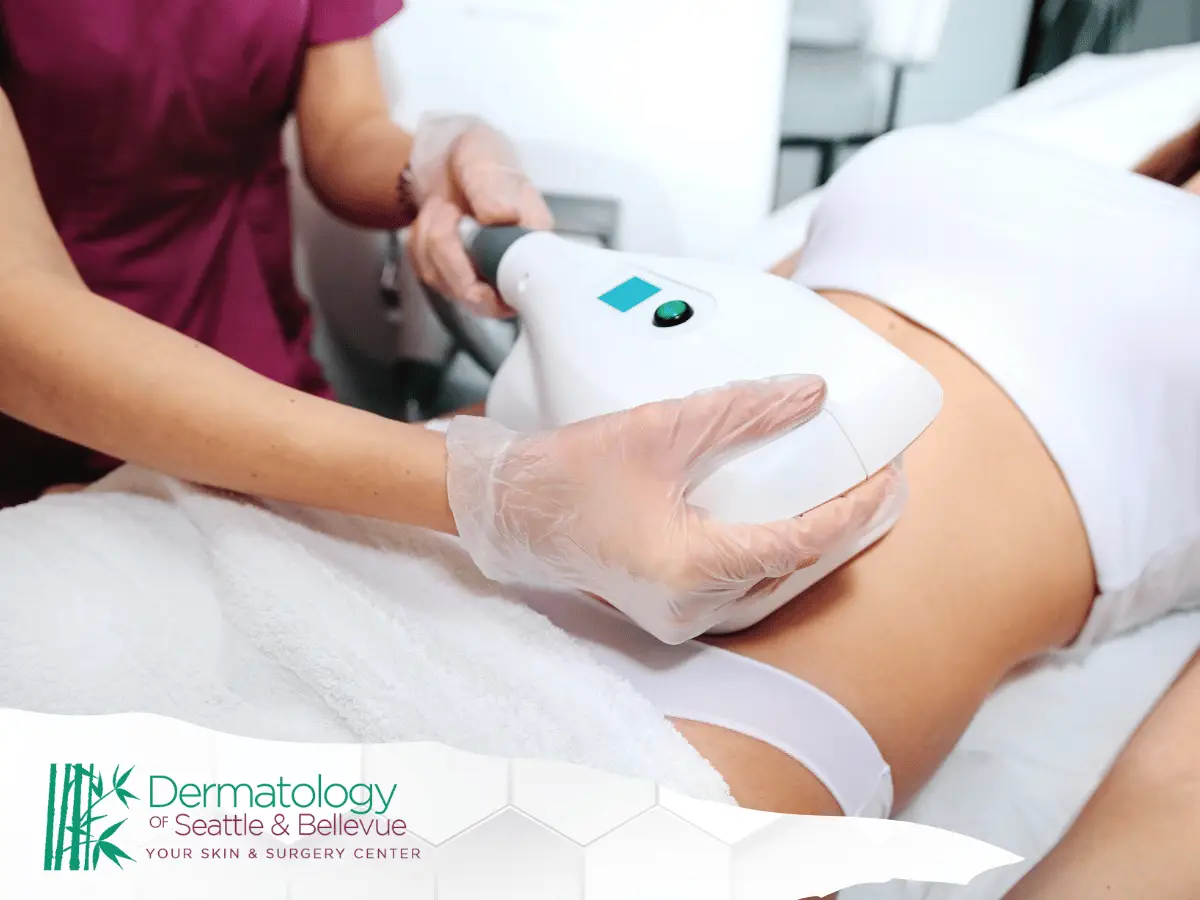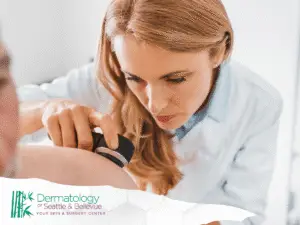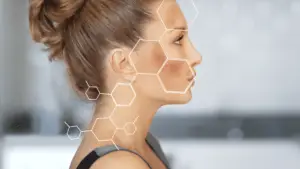CoolSculpting is one of the most popular noninvasive body contouring procedures available today, giving patients a way to target stubborn fat without surgery. Using the science of cryolipolysis, this treatment freezes fat cells until they break down and are naturally eliminated by the body. Unlike traditional fat reduction procedures, CoolSculpting requires no anesthesia, no scalpels, and little to no downtime, making it an appealing option for those seeking visible results with minimal interruption to daily life.
What Is CoolSculpting?
Quick Summary
- CoolSculpting is a noninvasive body contouring procedure that uses cryolipolysis to freeze and destroy subcutaneous fat cells without surgery, anesthesia, or significant downtime.
- Controlled cold targets fat cells (more cold-sensitive than surrounding tissue), causing crystallization and apoptosis while leaving skin, nerves, and muscle largely unharmed.
- The body gradually clears the damaged fat cells through immune processes and the lymphatic system, with results typically starting around 3 weeks and peaking at 2–3 months.
- The procedure uses a gel pad and applicator with gentle suction for 35–60 minutes per area; patients can usually return to normal activities immediately afterward.
- Common side effects include temporary redness, swelling, bruising, numbness, or tingling; rare risks include paradoxical adipose hyperplasia and other uncommon inflammatory reactions.
CoolSculpting is a fat reduction procedure based on cryolipolysis, a method that selectively destroys fat cells by exposing them to controlled cold temperatures. The procedure is FDA-cleared for several treatment areas, including the thighs, stomach, love handles, bra fat, buttocks, and even under the chin. By focusing only on the fat layer beneath the skin, CoolSculpting leaves other tissues unharmed, which is why it has gained popularity as a safe, noninvasive treatment.
The Science Of Cryolipolysis
The science behind cryolipolysis comes from the observation that fat cells are more sensitive to freezing than other tissues. When exposed to cold, fat cells crystallize and eventually die, while surrounding skin, nerves, and muscle remain intact. Over the following weeks, the body naturally processes and eliminates the frozen fat cells through the lymphatic system. This gradual fat loss leads to lasting results without the risks associated with cosmetic surgery.
How CoolSculpting Targets Fat Cells
CoolSculpting focuses on subcutaneous fat, the layer of fat just beneath the skin that can be resistant to diet and exercise. By applying controlled cold temperatures directly to these fat deposits, the treatment selectively freezes fat cells without harming other tissues. This precision makes it an effective option for body contouring in areas where stubborn fat tends to linger.
Why Freezing Works On Fat Cells
Fat cells respond differently to cold compared to skin, nerves, or muscle. When exposed to freezing, the fat cell walls crystallize, leading to cell death. Since the body does not regenerate these fat cells, the reduction is permanent. This selective response explains why cryolipolysis is both safe and effective, providing fat reduction without damaging other tissues.
What Happens To Frozen Fat Cells
After CoolSculpting, the frozen fat cells undergo a process known as apoptosis, or natural cell death. Over the next several weeks, the body’s immune system, including macrophages, works to clear away the damaged fat cells. Patients won’t notice immediate changes right after treatment, but results gradually improve, with the most visible outcomes typically appearing within two to three months.
The Procedure Step By Step
CoolSculpting is designed to be simple and patient-friendly. Each session typically lasts 35–60 minutes depending on the treatment area. Patients can read, relax, or even check emails during the procedure since no anesthesia is required. Once the session is complete, they can usually return to normal activities immediately, making it one of the most convenient fat reduction procedures available today.
Treatment Area And Process
The procedure begins with the placement of a gel pad and applicator on the chosen treatment area, such as the thighs, stomach, or love handles. The device delivers controlled cold temperatures to the fat layer beneath the skin, drawing the tissue into the applicator using gentle suction. Patients may feel a cooling or pulling sensation at first, but this typically fades as the area becomes numb.
Safety And Efficacy
CoolSculpting is FDA-cleared and backed by clinical studies demonstrating its safety and efficacy. Because it selectively targets fat cells while sparing other tissues, it is considered a low-risk treatment for healthy patients. While results vary, most patients see about 20–25% fat reduction in the treated area after one session, with lasting results as long as a stable weight is maintained.
CoolSculpting Vs. Liposuction
When it comes to fat removal, liposuction and CoolSculpting are often compared. Liposuction is a surgical procedure that physically removes large volumes of fat through suction, usually performed by a plastic surgeon under anesthesia. CoolSculpting, on the other hand, is a noninvasive body contouring treatment designed for targeted fat reduction. While liposuction may provide faster and more dramatic fat loss, CoolSculpting offers a safer option with no surgery, no scars, and little to no downtime.
Noninvasive Procedure Vs. Invasive Treatment
The difference between these two options comes down to invasiveness:
- CoolSculpting (noninvasive procedure): No anesthesia, needles, or surgical incisions. Patients walk in and out the same day and resume normal activities.
- Liposuction (invasive treatment): Requires anesthesia, surgical incisions, and a recovery period. Risks such as infection, bleeding, and scarring are higher.
For patients with small, stubborn fat deposits who don’t want surgery, CoolSculpting provides an appealing alternative.
Benefits Of CoolSculpting
CoolSculpting offers several benefits beyond fat reduction. Patients appreciate that the procedure is noninvasive, requires no downtime, and delivers natural-looking results. It is particularly effective for treating stubborn fat in areas resistant to diet and exercise, such as the thighs, stomach, and love handles.
Lasting Results And Effectiveness
One of the biggest advantages of CoolSculpting is its lasting results. Once fat cells are frozen and removed from the body, they don’t return. Patients can expect permanent fat loss in the treated area as long as they maintain a healthy lifestyle. While CoolSculpting is not a weight loss solution, it is highly effective for body contouring and reducing localized fat deposits. Clinical studies on the effectiveness of cryolipolysis show consistent results, with most patients experiencing visible improvements within a few months.
Side Effects And Risks
Like any medical procedure, CoolSculpting carries some risks. Fortunately, most are mild and temporary. Patients should understand potential side effects before starting treatment so they know what to expect and can make informed decisions with their dermatologist.
Common Side Effects
The most common side effects include temporary redness, swelling, bruising, or numbness in the treatment area. Some patients also report a tingling or aching sensation as the body adjusts after freezing. These side effects usually resolve within days or weeks without the need for additional treatment.
Rare Conditions Like Adipose Hyperplasia
Although very rare, some patients may experience paradoxical adipose hyperplasia — a condition where, instead of shrinking, fat cells in the treated area enlarge after the procedure. This happens in a small fraction of cases and may require additional fat removal procedures to correct. Another uncommon reaction is popsicle panniculitis, an inflammatory response first observed in children who ate too many popsicles, which helped inspire the science of cryolipolysis. While rare, these risks highlight the importance of having CoolSculpting performed under the supervision of experienced dermatology professionals.
Cost Of CoolSculpting
The cost of CoolSculpting depends on several factors, including the size of the treatment area, the number of sessions required, and the patient’s overall goals. Smaller areas like under the chin generally cost less than larger regions such as the thighs, stomach, or buttocks. Since CoolSculpting is considered a cosmetic procedure, it is not covered by insurance, but many dermatology practices offer flexible payment options to make treatments more accessible.
Who Is A Good Candidate?
CoolSculpting is designed for patients who are close to their ideal weight but struggle with stubborn fat deposits that don’t respond to diet and exercise. It is not a weight loss solution or a treatment for obesity. The best candidates are healthy adults with realistic expectations who want targeted fat reduction in areas such as the outer thighs, stomach, or love handles. A consultation helps determine whether this fat reduction procedure is the right fit.
Results And Recovery
CoolSculpting delivers gradual results rather than overnight changes. After treatment, the body needs time to process and eliminate the frozen fat cells. Most patients begin to notice improvements within three weeks, with full results becoming visible after two to three months. Because the fat loss is natural and progressive, the body adapts smoothly, making the changes look subtle yet noticeable.
How The Body Eliminates Fat Cells
Once fat cells are frozen, the body identifies them as damaged and triggers an inflammatory response. Macrophages — specialized immune cells — begin breaking down the crystallized fat cells, carrying them away through the lymphatic system. Over time, this process permanently reduces fat deposits in the treated area. Since the body does not regenerate new fat cells, the reduction is long-lasting.
What To Expect After Treatment
Patients can typically return to their normal routines immediately after a CoolSculpting session. Some may experience temporary numbness, redness, or swelling in the treatment area, but these effects usually fade within a few days or weeks. Visible results continue to improve over time, and many patients schedule multiple sessions to achieve their desired outcome. With proper care, the benefits of CoolSculpting can be long-lasting.
Lifestyle And Long-Term Success
While CoolSculpting permanently removes treated fat cells, maintaining the results depends on lifestyle. Remaining fat cells can still expand with weight gain, so a balanced approach is key. Patients are encouraged to:
- Follow a healthy diet rich in whole foods
- Stay consistent with exercise
- Maintain a stable weight to protect results
CoolSculpting is best seen as a complement to diet and exercise, not a replacement. By combining the treatment with healthy habits, patients can enjoy lasting results and improved confidence in their body contour.
Conclusion
The science behind CoolSculpting: Freeze away fat, not your coffee shows how cryolipolysis offers a safe, effective, and noninvasive procedure for fat reduction. By freezing fat cells without harming other tissues, CoolSculpting delivers results that last when paired with a healthy lifestyle. For patients looking to target stubborn fat areas like the thighs, stomach, or love handles, this fat reduction procedure offers an alternative to plastic surgery with fewer risks and no downtime.
Disclaimer
This article is intended for informational purposes only and should not replace professional medical advice. CoolSculpting and other fat reduction procedures should always be discussed with a qualified dermatologist or healthcare provider to determine if they are appropriate for your health, body, and treatment goals. This article is intended for informational purposes only and should not replace professional medical advice. CoolSculpting and other fat reduction procedures should always be discussed with a qualified dermatologist or healthcare provider to determine if they are appropriate for your health, body, and treatment goals.
Additionally, it’s essential to explore various options available in your area, such as Burien laser treatment services, which may complement your fat reduction goals.
Consultation with a specialist will provide further insight into the latest techniques and technologies designed to enhance body contouring outcomes. Always prioritize safety and efficacy when considering cosmetic procedures tailored to your individual needs. This article is intended for informational purposes only and should not replace professional medical advice. CoolSculpting and other fat reduction procedures should always be discussed with a qualified dermatologist or healthcare provider to determine if they are appropriate for your health, body, and treatment goals. This article is intended for informational purposes only and should not replace professional medical advice.
CoolSculpting and other fat reduction procedures should always be discussed with a qualified dermatologist or healthcare provider to determine if they are appropriate for your health, body, and treatment goals.Additionally, it’s essential to explore various options available in your area, such as Burien laser treatment services, which may complement your fat reduction goals. Consultation with a specialist will provide further insight into the latest techniques and technologies designed to enhance body contouring outcomes. Always prioritize safety and efficacy when considering cosmetic procedures tailored to your individual needs.
In addition to fat reduction treatments, exploring skin rejuvenation techniques in bellevue can contribute to an overall enhancement of your appearance. Many facilities offer a range of innovative options that can improve skin texture and elasticity, complementing your body sculpting efforts. By combining these approaches, you can achieve a more comprehensive aesthetic result tailored to your personal preferences.




